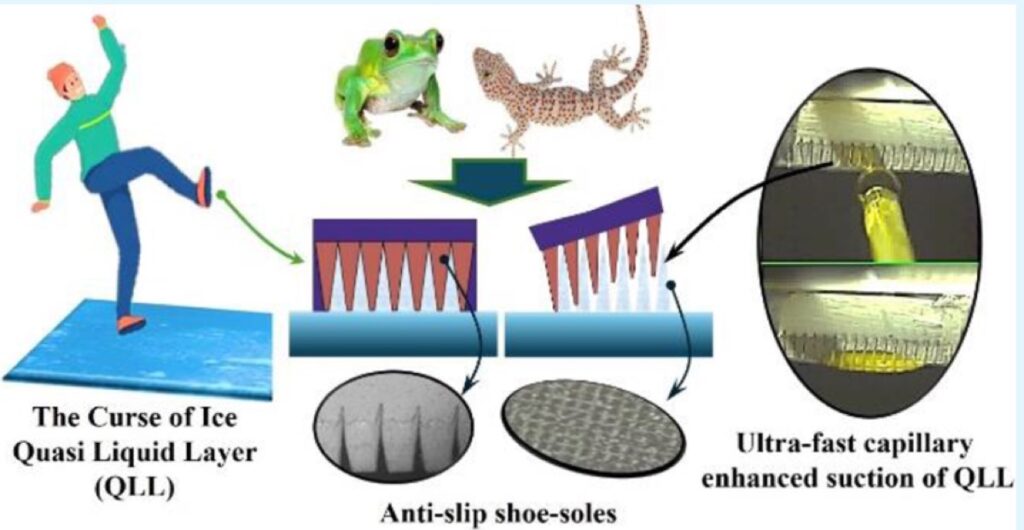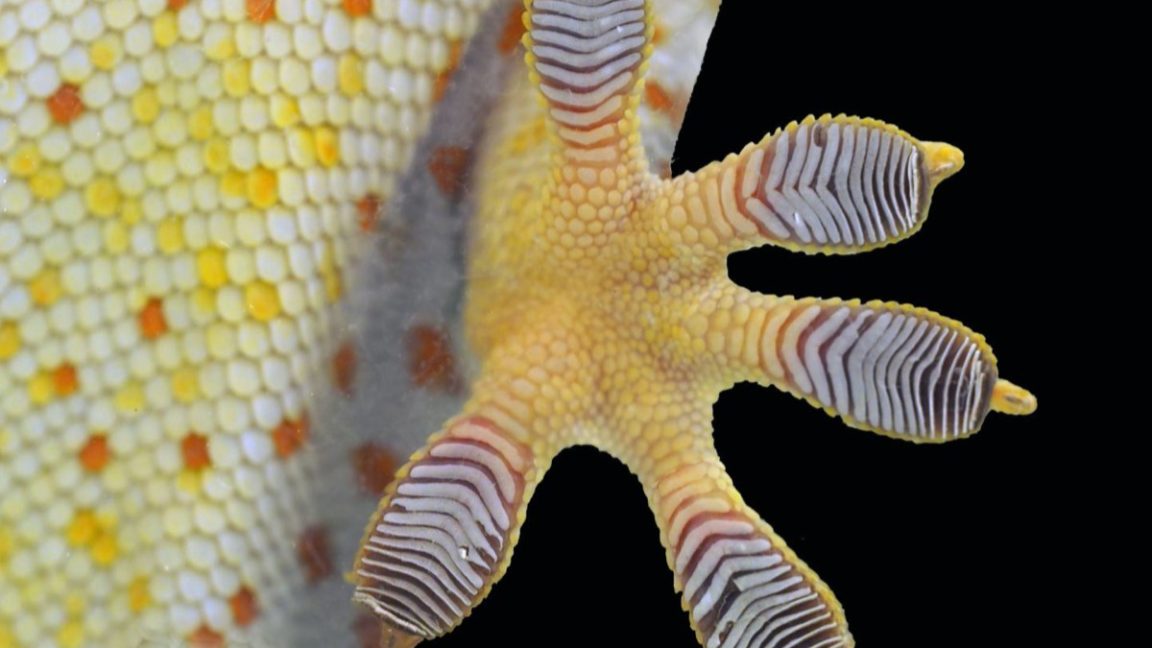Adding zirconia nanoparticles to the mix enhances slip-resistant hydrophilic effects.
Gecko feet have inspired many intriguing applications, including a sticky tape, adhesives, a "stickybot" climbing robot, and even a strapless bra design. Now, scientists have developed a new kind of anti-slip polymer that sticks to ice, inspired by the humble gecko. Incorporating these polymers into shoe soles could reduce the number of human slip-and-fall injuries, according to a paper published in the journal ACS Applied Materials & Interfaces.
As previously reported, geckos are known for being expert climbers; they're able to stick to any surface thanks to tiny hair-like structures on the bottoms of their feet. Those microscopic hairs are called setae, each of which splits off into hundreds of even smaller bristles called spatulae. It has long been known that at microscopic size scales, the so-called van der Waals forces—the attractive and repulsive forces between two dipole molecules—become significant.
Essentially, the tufts of tiny hairs on gecko feet get so close to the contours in walls and ceilings that electrons from the gecko hair molecules and electrons from the wall molecules interact with each other and create an electromagnetic attraction. That's what enables geckos to climb smooth surfaces like glass effortlessly. Spiders, cockroaches, beetles, bats, tree frogs, and lizards all have varying-sized sticky footpads that use these same forces.
Geckos and their unusual feet have long been of great interest to scientists. In 2013, for instance, researchers designed a reusable dry adhesive inspired by the gecko's feet that easily stuck to smooth surfaces, adhering strongly when pushed forward and sliding off when pulled backward. In 2020, Berkeley scientists investigated why soft, hairy gecko toes only "stick" in one direction. And in 2022, scientists found that gecko feet are coated with an ultra-thin layer of lipid molecules in an upright orientation. This might serve to push away any water beneath the spatulae, allowing the spatulae to make closer contact with the surface, thereby helping the geckos maintain their grip on wet surfaces.
Just add zirconia nanoparticles...

It's the "hydrophilic capillary-enhanced adhesion"of gecko feet that most interested the authors of this latest paper. Per the World Health Organization, 684,000 people die and another 38 million are injured every year in slips and falls, with correspondingly higher health care costs. Most antislip products (crampons, chains, studs, cleats), tread designs, or materials (fiberglass, carbon fiber, rubber) are generally only effective for specific purposes or short periods of time. And they often don't perform as well on wet ice, which has a nanoscale quasi-liquid layer (QLL) that makes it even more slippery.
So Vipin Richhariya of the University of Minho in Portugal and co-authors turned to gecko toe pads (as well as those of toads) for a better solution. To get similar properties in their silicone rubber polymers, they added zirconia nanoparticles, which attract water molecules. The polymers were rolled into a thin film and hardened, and then a laser etched groove patterns onto the surface—essentially creating micro cavities that exposed the zirconia nanoparticles, thus enhancing the material's hydrophilic effects.
Infrared spectroscopy and simulated friction tests revealed that the composites containing 3 percent and 5 percent zirconia nanoparticles were the most slip-resistant. "This optimized composite has the potential to change the dynamics of slip-and-fall accidents, providing a nature-inspired solution to prevent one of the most common causes of accidents worldwide," the authors concluded. The material could also be used for electronic skin, artificial skin, or wound healing.
DOI: ACS Applied Materials & Interfaces, 2025. 10.1021/acsami.4c14496 (About DOIs).
Hope you enjoyed this news post.
Thank you for appreciating my time and effort posting news every day for many years.
News posts... 2023: 5,800+ | 2024: 5,700+ | 2025 (till end of January): 487
RIP Matrix | Farewell my friend ![]()



3175x175(CURRENT).thumb.jpg.b05acc060982b36f5891ba728e6d953c.jpg)
Recommended Comments
There are no comments to display.
Join the conversation
You can post now and register later. If you have an account, sign in now to post with your account.
Note: Your post will require moderator approval before it will be visible.